The importance of customer feedback and collecting Voice of the Customer has only increased with today’s technology. Previously, advertising for companies consisted of getting famous celebrities like Madonna or Michael Jordan to appear in a commercial or billboard with a product and sales would soar. Convincing customers was easy.
Today, however, 91% of consumers read at least one online review before purchasing a product or service (1).
Welcome to the feedback economy.
So, what is the feedback economy?
[ca-form id=”194451″ align=”left” var1=”https://www.customer-alliance.com/wp-content/uploads/2021/08/customer-alliance-feedback-economy-guide-download-1.pdf”]
The feedback economy is defined as how a business collects, analyses, and leverages customer input to beat out their competitors in customer satisfaction.
Consumers provide public feedback via reviews, ratings, and social media, and also private feedback with surveys. We can group all of this as Voice of the Customer (VoC).
We live in the feedback economy every day
Now the Voice of the Customer plays a huge role in a brand’s success. Why?
A SurveyMonkey report found that 82% of consumers trust the voice of the customers more than a brand’s own messages (2). Clever advertising no longer does the trick. People today crave authenticity.
As a result, 58% of companies are already investing in some form of feedback collection and this percentage is expected to increase each year (3).
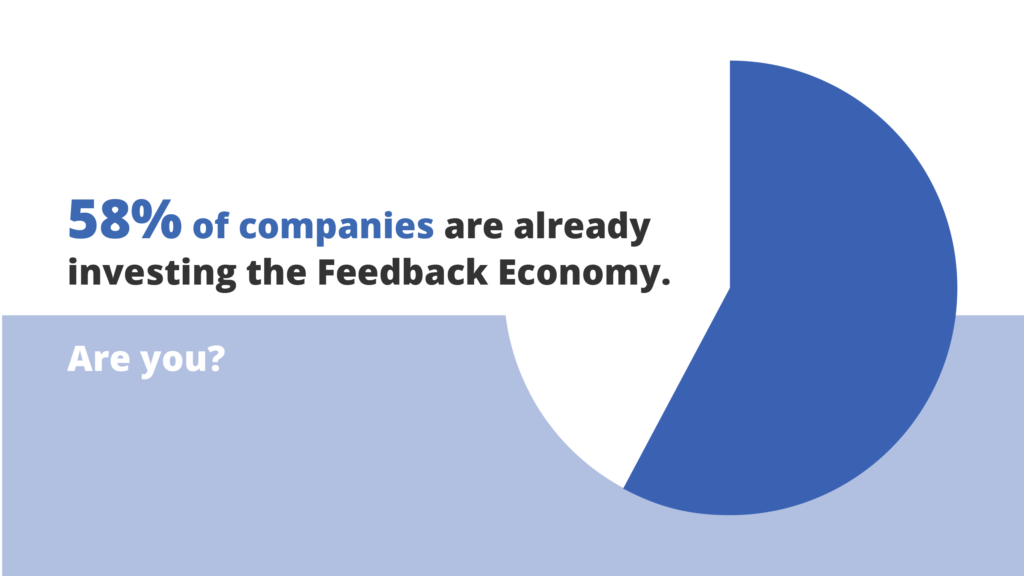
You’re either using it, or you’re losing it.
8 reasons the feedback economy is important
The feedback economy not only provides a wealth of information about your customers and employees, it provides potential customers with transparent evaluations of your company’s products and services. We’ve 8 reasons why you should invest in the feedback economy.
#1 It affects your online reputation
Before you go to a restaurant or book a hotel, what do you do? You research online about the place and read the reviews. And this is across industries. The importance of customer feedback will reveal itself in your online reputation management.
Almost half of today’s customers won’t do business with a company that has less than a 4-star rating (4).
Does your business have high ratings and enough good reviews to build consumer trust?
#2 It drives purchasing decisions
[ca-form id=”44600″ align=”right”]
As a revenue driver, the importance of feedback cannot be underestimated. It’s what consumers care about.
Once potential customers are on your website, will they buy? First, we can assure you, they will see what other customers have to say about your products or services. It’s essential to have a good amount of reviews on your website to provide social proof.
Consider these 2 statistics:
- 93% of consumers say online reviews impact their purchasing decisions (5).
- A product with 5 reviews can boost conversion up to 270% compared to that with 0 reviews (6).
Bottom line—reviews matter.
#3 It provides valuable customer experience insights
“Your most unhappy customers are your greatest source of learning.” —Bill Gates
Both positive and negative feedback provide excellent learning opportunities. If you ask customers about their experience at specific touchpoints as well as their overall experience and thoughts on your branding, they will tell you.
You can learn customers’ pain points and conversely, what delights them about their experience. From there, you’ll be able to improve products, services, information, and advertising.
P.S. Customers who’ve had a positive experience spend 140% more than those who encountered a negative one (7). One word—compelling.
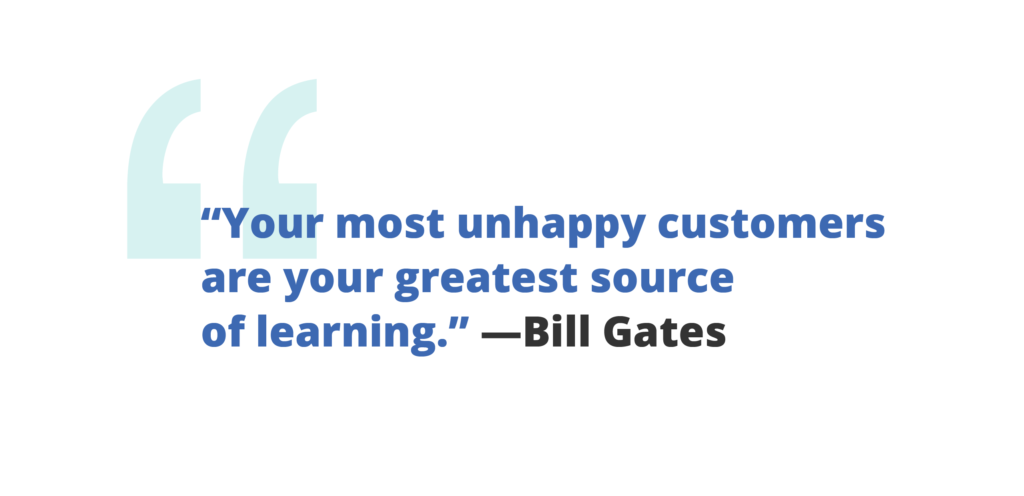
#4 It can identify customer loyalty and satisfaction
Using customer satisfaction metrics within a survey, companies can check in with current customers regarding their overall satisfaction and/or satisfaction with a certain product, service, or touchpoint.
Did you know that 80% of companies use customer satisfaction scores to analyse customer experience and improve it (8)?
We’ll get into specific satisfaction metrics for feedback like NPS, Customer Effort Score, and CSAT below.
Additionally, you can use customer satisfaction feedback to identify those customers who you can turn into brand promoters as well as those who might be more likely to churn soon.
#5 It offers direction for product
Product teams and service teams often perform feedback analysis to glean data for tips for improvement. But they can go even further to ask specific product or service-related questions in a survey.
Product teams can use surveys to get:
- Research about new markets
- Suggestions about related products
- Improvements on product usability
- Ideas on new features to gain the competitive edge
74% of customer experience professionals say they generate new product ideas from customer feedback (9).
Customers know what they need. Ask them.
#6 It allows you to control for performance
When your company applies customer satisfaction metrics to customer feedback surveys, you can monitor performance across your company. Therefore, you can use feedback to track how specific employees, locations, and touchpoints are performing.
Example questions: on a scale from 1 to 10,
- How was your experience today with our server Anna? (specific employee)
- How was your experience today at the automotive dealership at *___* (specific location)
- How satisfied are you with your checkout experience today? (specific touchpoint)
- Would you recommend us to your friends and colleagues? (overall customer satisfaction/NPS)
This is particularly useful for enterprise companies to set benchmarks internally and based on external standards.
#7 It can identify potential customer churn
81% of customers who switched brands said that the previous company could have prevented it (10).
Most customers will simply take their business elsewhere without complaining. Brands that proactively ask customers for feedback, perform customer experience analysis, and take action are more likely to reduce customer churn.
You can check in with your customers to identify which ones are at-risk to churn, uncover your weaknesses, and consequently, determine where you need to step up your game.
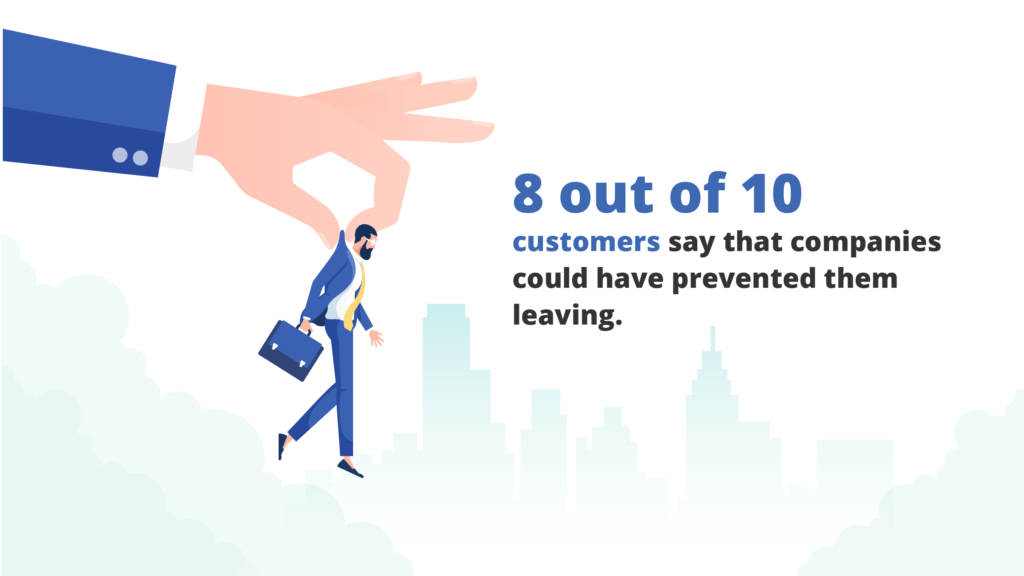
But, if you don’t ask, you won’t know.
# 8 It’s a tool for employee engagement
A highly engaged workforce increases profitability by 21% (11). Read that again—21%!
Employee satisfaction is well worth your investment. Therefore, routinely, and sincerely, check in with your employees.
Ways to use feedback to engage employees:
- Check in regarding employee satisfaction
- Ask them for insights on customers
- Oversee their product/service understanding
- Understand their motivations at your company
Then, act on their feedback. Don’t just offer lip service, offer a changed outcome. Similar to your customers, requesting, and acting on feedback lets employees know you care about their opinions.
Tools of the feedback economy
There are several important tools companies use to leverage the feedback economy. Collecting Voice of the Customer data is essential to be able to provide the customers with what they need. We recommend the following customer feedback tools:
Surveys
Customer feedback survey questions are the golden child of the feedback economy. They help uncover what delights and frustrates customers, how they feel about your brand, how easy it is to use your product or services, and what they think about a particular product or touchpoint.
Surveys are scalable, provide analytics and data over time, and are inexpensive. There’s no reason not to be using them. We’ve compiled a list below of the different types of surveys.
Types of surveys:
- Customer satisfaction survey
- Customer experience survey
- Market research survey
- Employee satisfaction survey
- User experience survey
Sharing your Voice of the Customer surveys has never been easier. Consider the following methods and identify which ones would work best for your customers: email, text message, chat, in-app, beacon, WiFi start page, QR code, tablet, or social media.
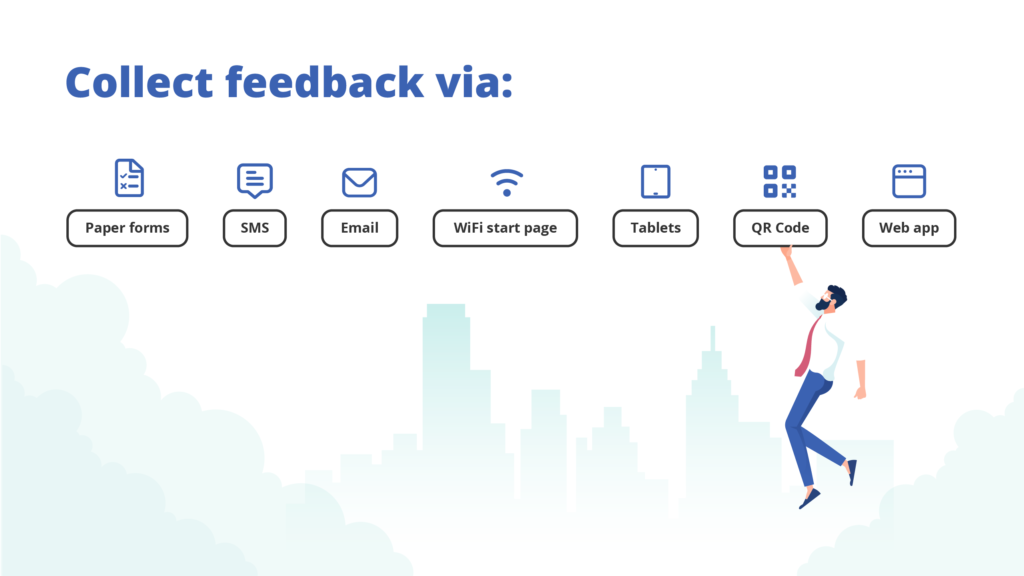
Interviews
Taking the time to go deeper with customer interviews and studying customer answers will be a treasure trove for your feedback analysis.
You can hold interviews over email, phone or onsite with a customer to gather feedback in customers’ own words about your product, service, or overall brand experience.
A focus group, an interview of several customers at one time, can also be valuable. To read more in-depth on interviews and focus groups, check out Voice of the Customer Tools to Improve Customer Experience.
Social media
Social media is a great place to listen to what customers are saying about your brand and engage with them. Determine which platforms the majority of your users are active on: Instagram, Facebook, TikTok, Twitter, or LinkedIn?
Many customers like the direct messaging these platforms provide if companies proactively use them. In fact, many companies now use social media as a customer support service platform, answering customer issues and questions. Or, in gathering customer information eCommerce sites are taking major advantage of social media to advertise and communicate with potential customers about their products.
There are many possibilities, but you first need to define your target audience, resources, and social media platforms before diving into social media listening. In conclusion, customers want to see that brands value the importance of customer feedback.
Customer feedback metrics
It’s essential for proper feedback analysis that you measure certain aspects of your customer feedback efforts. We recommend including one or two of the following metrics in your customer feedback strategy. In doing so, you can monitor and control for performance.
Net Promoter Score (NPS)
The Net Promoter Score measures customer loyalty and satisfaction over time with this frequently asked question, “How likely are you to recommend us to your friends and coworkers?”
Scored out of 10, this is the most popular satisfaction metric used by businesses. It allows companies to see which customers will promote them and which ones might leave them soon thanks to the NPS calculator of promoters and detractors.
Customer Satisfaction Score (CSAT)
Another popular metric is the Customer Satisfaction Score. The CSAT is employed to monitor customer satisfaction at particular moments in the customer journey. An example of this 5-point scale question is, “How would you rate your recent experience with our Customer Support?
As the CSAT can be used at multiple touchpoints, it’s a great tool for businesses to see what motivates or frustrates their customers throughout the customer journey.
Customer Effort Score (CES)
As the name suggests, the Customer Effort Score is utilised by companies to see how difficult a task was for a customer to complete. The scaling varies, from 7, 5, or 10-point scale, which all measure the degree of difficulty.
An example Customer Effort Score question would be, “How much do you agree with this statement? The information here made it easy to solve my issue?”
The Customer Effort Score is most often used to measure the customer experience and improve issue-resolve time.
Feedback analytics
Don’t ask questions just to show you care, ask to analyse. Then improve. You’ll get the most insights from the following feedback analysis tools:
Text analytics
The greater amount of feedback you collect, the more you’ll need a Voice of the Customer software to sift through the vast amount of unstructured data to make sense of it. This will give you objective results and allow you to have actionable insights from the customer feedback analysis.
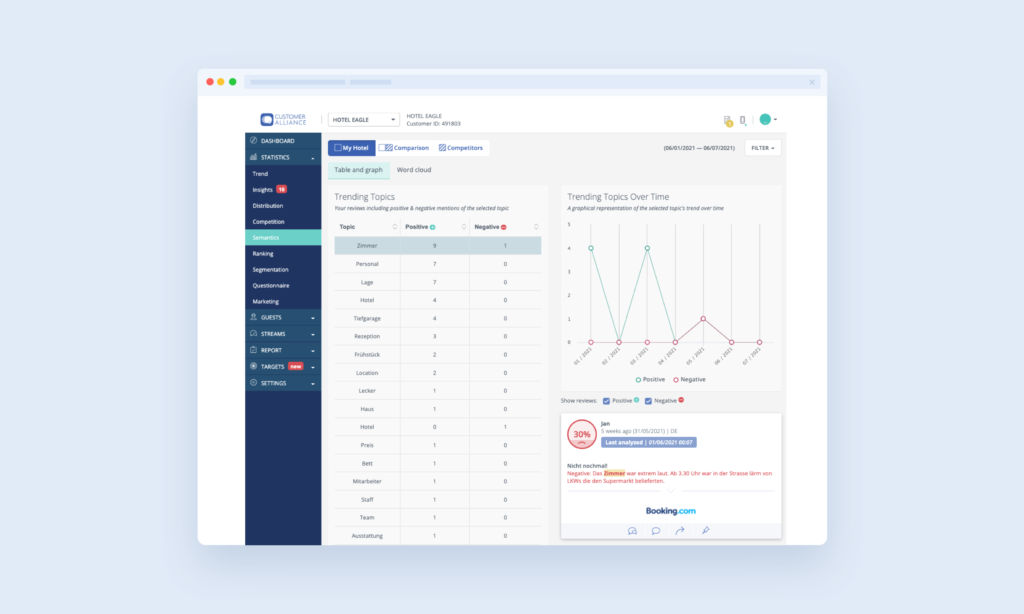
Whether it’s the open-ended questions in your surveys or online reviews, utilise text analytics to explore trends and themes in the customers’ feedback. This should be an essential part of your customer experience analysis.
Additionally, discover the meaning behind customers’ words with semantic analysis. This will tell you the connotation of their words—positive, negative, or neutral so you can know how they’re feeling about your brand, product, or service.
Voice of the Customer platform
If listening to your customers is a priority, then it’s essential to invest in a Voice of the Customer platform. It’ll help you collect authentic feedback from customers via reviews and surveys, understand satisfaction drivers, and allow you to act based on valuable insights.
What to look for in a Voice of the Customer platform?
Forrester reports that integrations, text analytics, and service offerings are major differentiators in feedback collection platforms across industries (12). Depending on the size of your company and which feedbacks you’d like to collect and analyse, you can determine which platform is best for your company.
How to win in the feedback economy
Once you commit to listening to customer feedback, act on it with your customer experience analysis! 74% of companies say they want to be data-driven, but only 29% are winning at acting on the analytics (13). Which are you?
Engage in online feedback
Proactively engage with the conversations people are having about your company online. Whether it’s via social media, review sites, or community pages, get involved in the discussion about your company. Show your company as a caring entity, invested in its customers.
Set goals
Most importantly, ensure your company is hitting its mark. So, set goals around collecting feedback.
This could be the response rate for the surveys you send out, the number of reviews collected, the average review score, and/or a benchmark of one of the customer satisfaction metrics we discussed above. Therefore, monitor your Customer Effort Score to improve specific touchpoints. Check in with customers’ satisfaction after an interaction with CSAT, and track customer loyalty over time with NPS.
Make feedback work for your company
Beyond monitoring for customer satisfaction, customer feedback can greatly enrich multiple client-facing areas of your company. So, consider sharing with the decision-makers at your company the importance of customer feedback. Perhaps sharing these ways to employ the Voice of the Customer will help:
Ways to utilise feedback:
- Improve touchpoints, products, and services based on feedback.
- Monitor multiple locations based on feedback scores like NPS.
- Display reviews directly on your website to boost conversion.
- Grow online ranking with customer feedback integrated on your site.
- Boost online rankings and stars with more & better reviews.
- Discover what makes customers tick and advertise accordingly.
- Use customers’ reviews in your marketing. The importance of customer feedback!
- Act on negative feedback and win back customers.
- Improve product and website usability with Customer Effort Score.
- Check in with employees regarding satisfaction & engagement to improve retention.
- Determine which customers will promote your brand and which ones are about to leave. (And take action!)
In short, the importance of customer feedback can no longer be underestimated. If you don’t listen to your customers, your competitors will.
Sources:
- Bizrate insights: The Impact of Customer Reviews on Purchase Decisions.
- SurveyMonkey Buyer trust report, 2018.
- Hubspot study: 42% of companies Don’t listen to their Customers
- Neil Patel: 97% of Customers Read Online Reviews. Here’s How to Make Sure Yours are in the Top 1%.
- Podium: State of Online Reviews.
- Spiegel Research Center. Report: Online Reviews
- Harvard Business Review. The Value of Customer Experience, Quantified.
- Harvard Business Review. Stop trying to delight your customers
- Forrester. Brief: Six Ways to Add Speed And Scale To Customer Insights.
- Acquire: The cost of Neglecting Customer Experience. Customer Effort Score.
- InMoment. How Employees Can Help you Grow Customer Loyalty & Value.
- The Forrester Wave CFM Platforms Q1 2021. InMoment. Keeping up with the Changing Times in CX technology and services.
- Forrester. Think you want to be data-driven? Insight is the new data.
